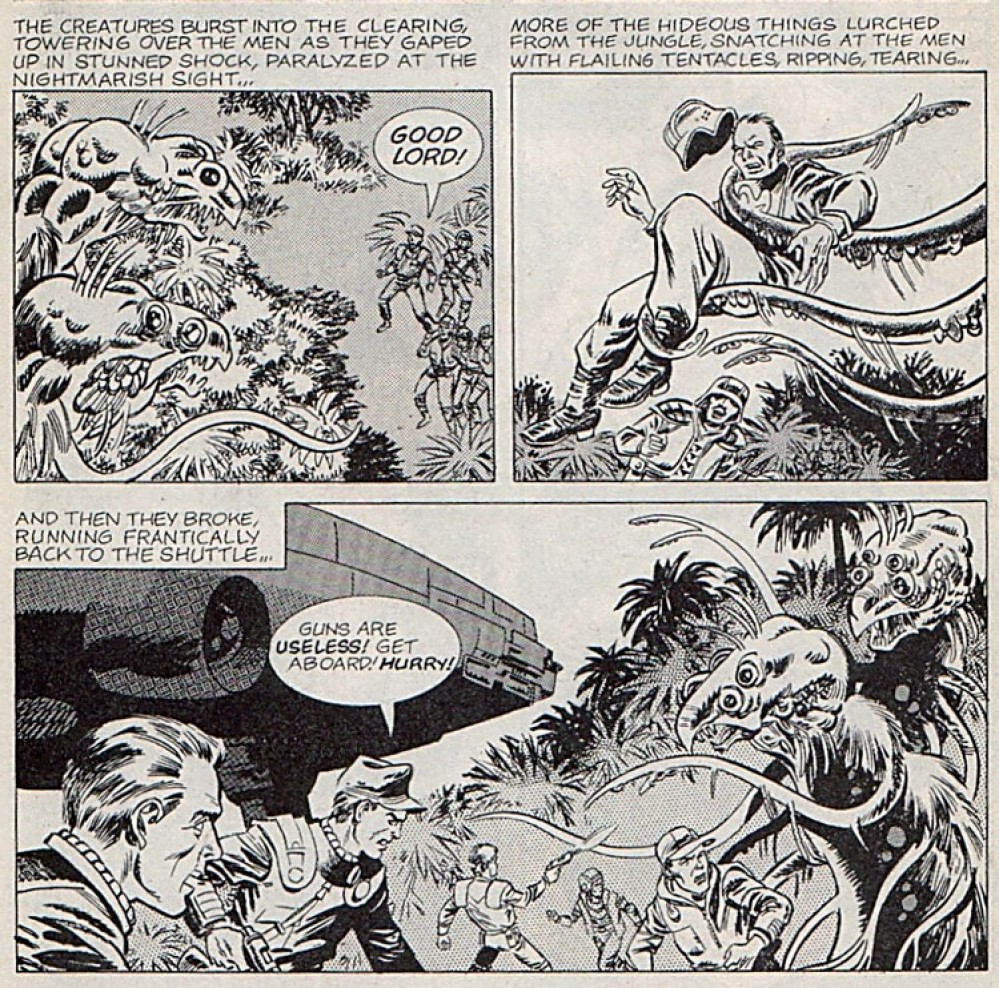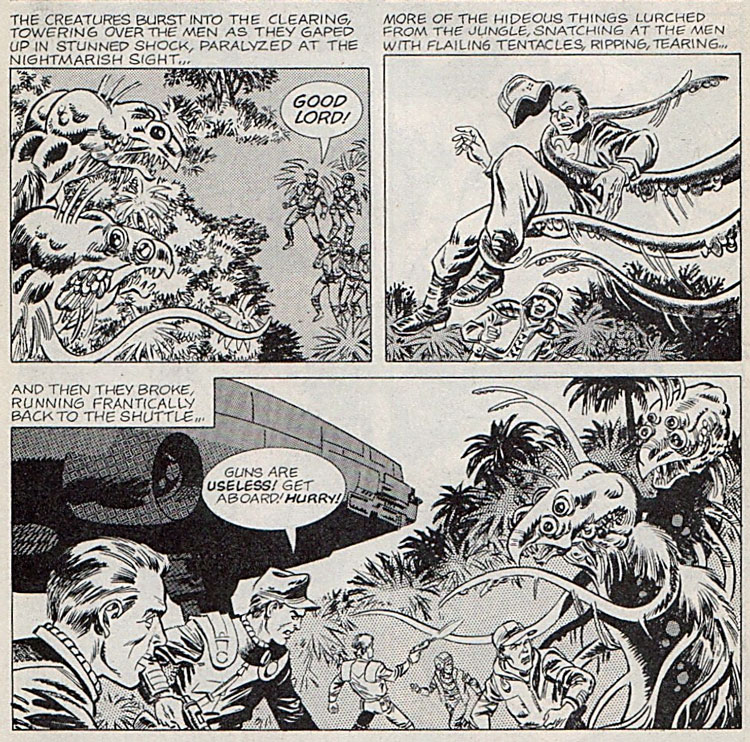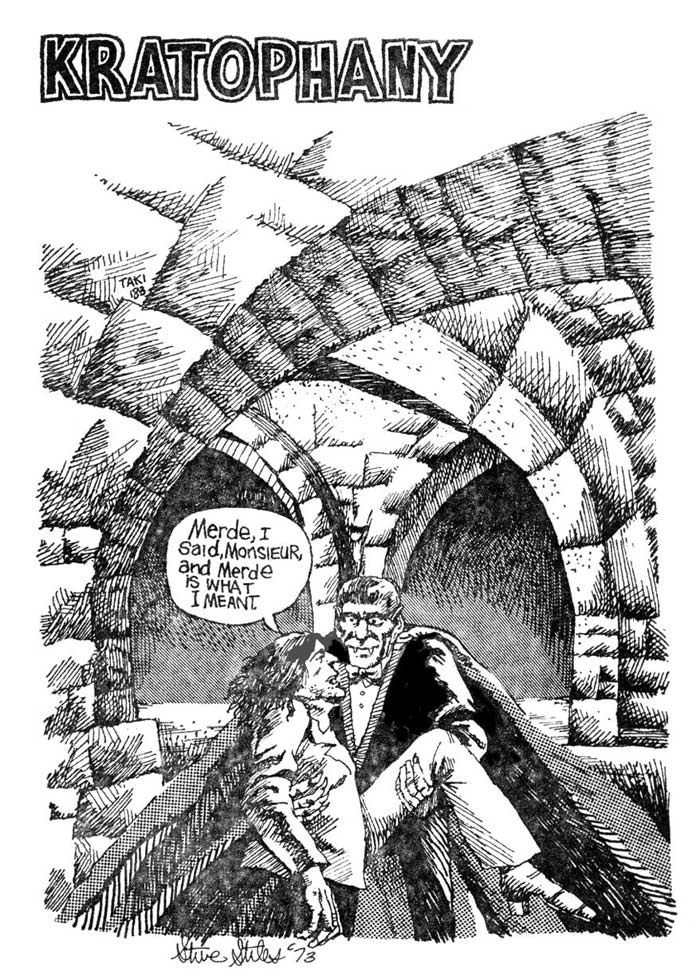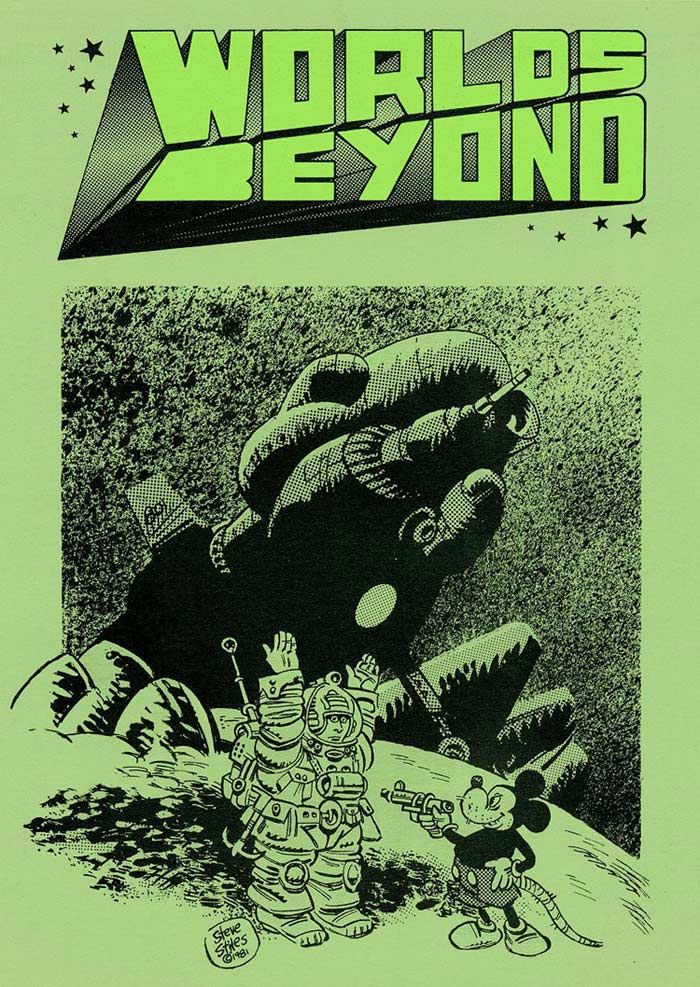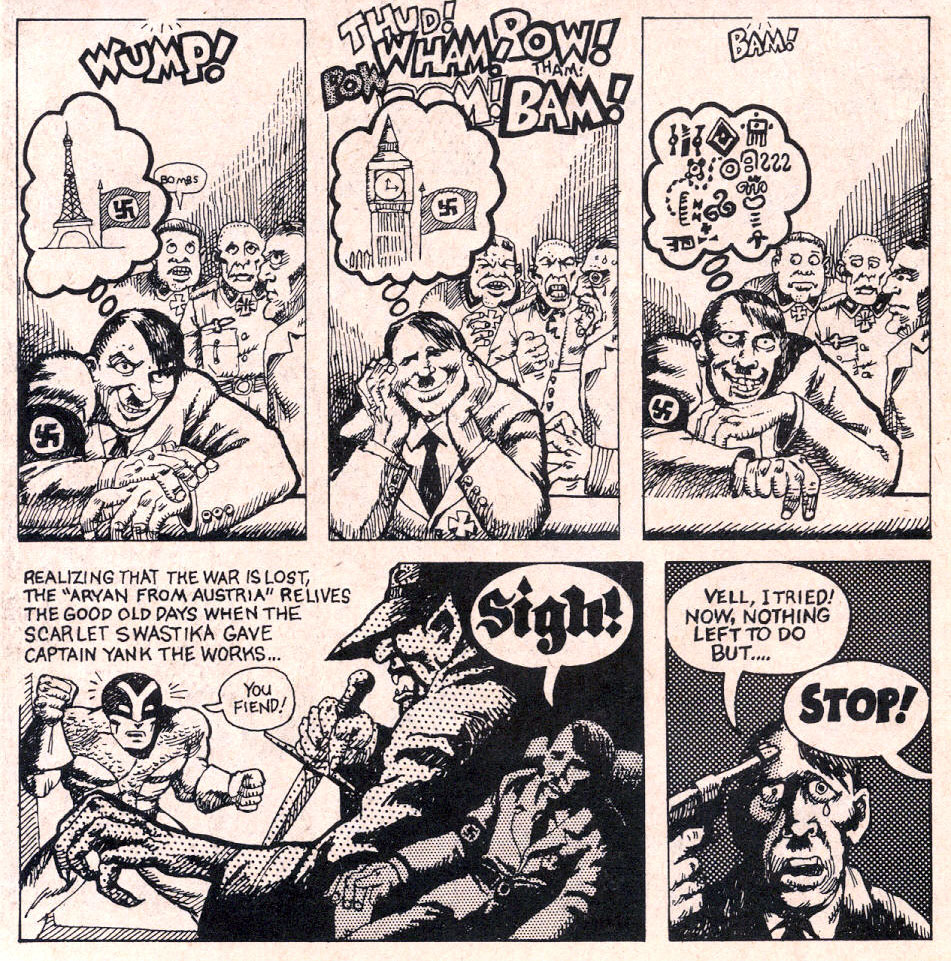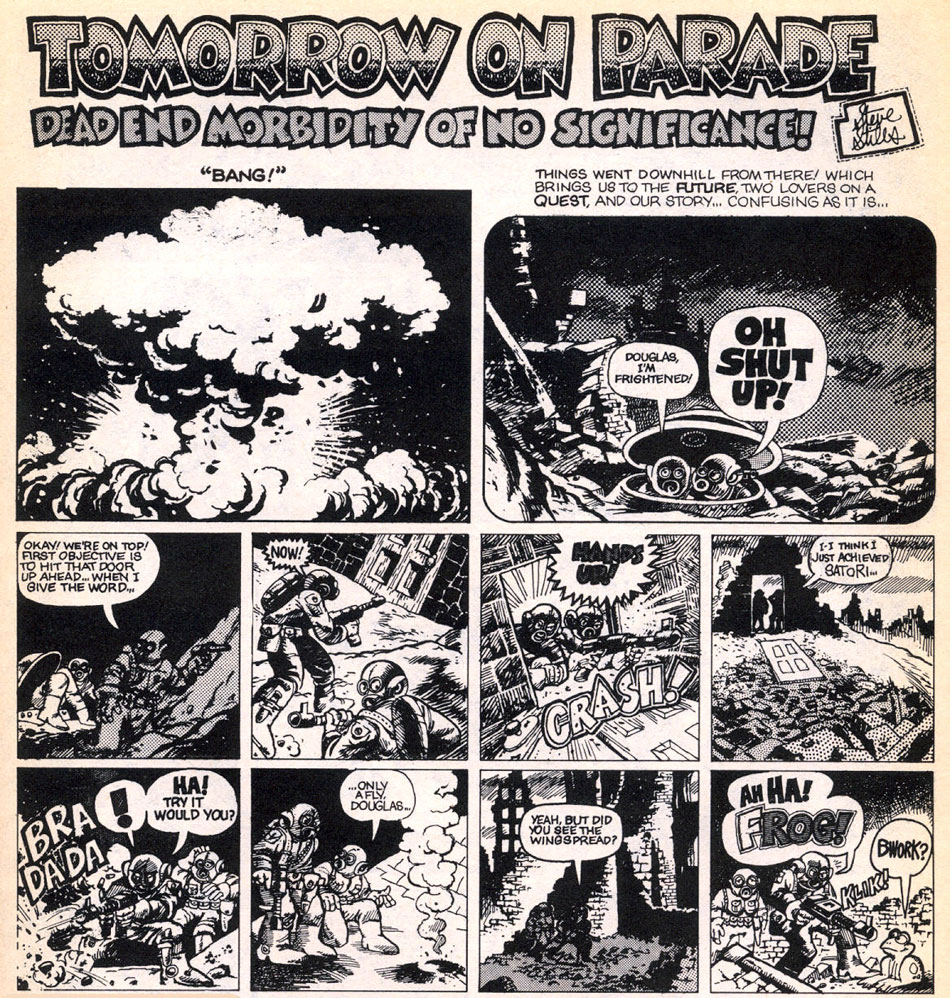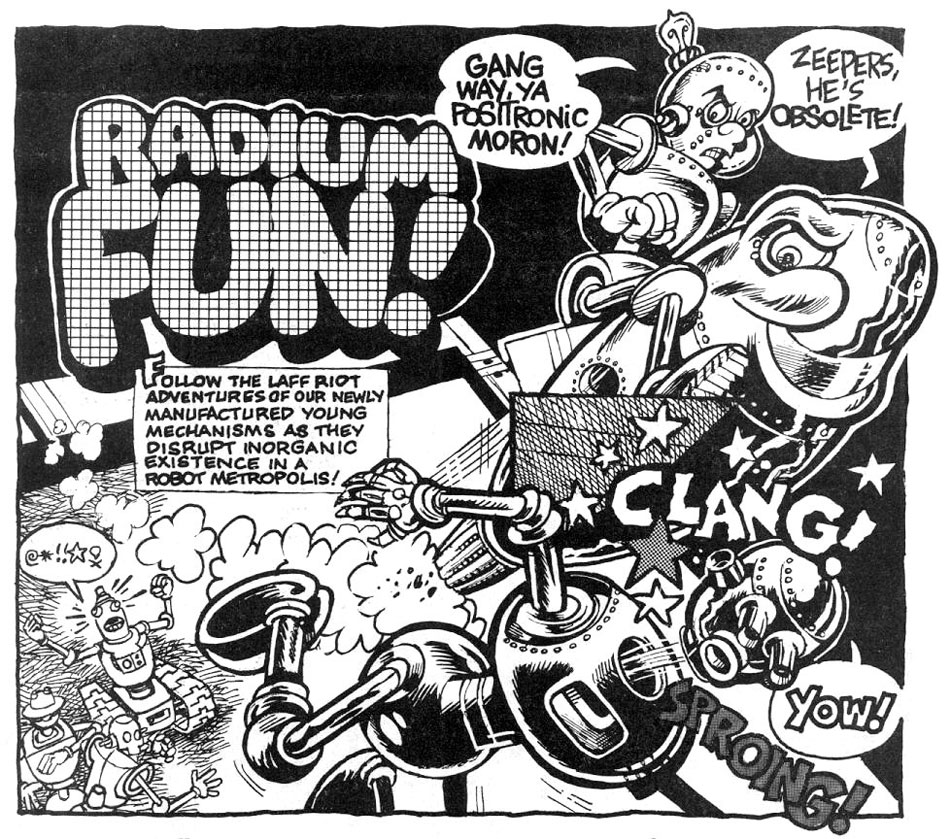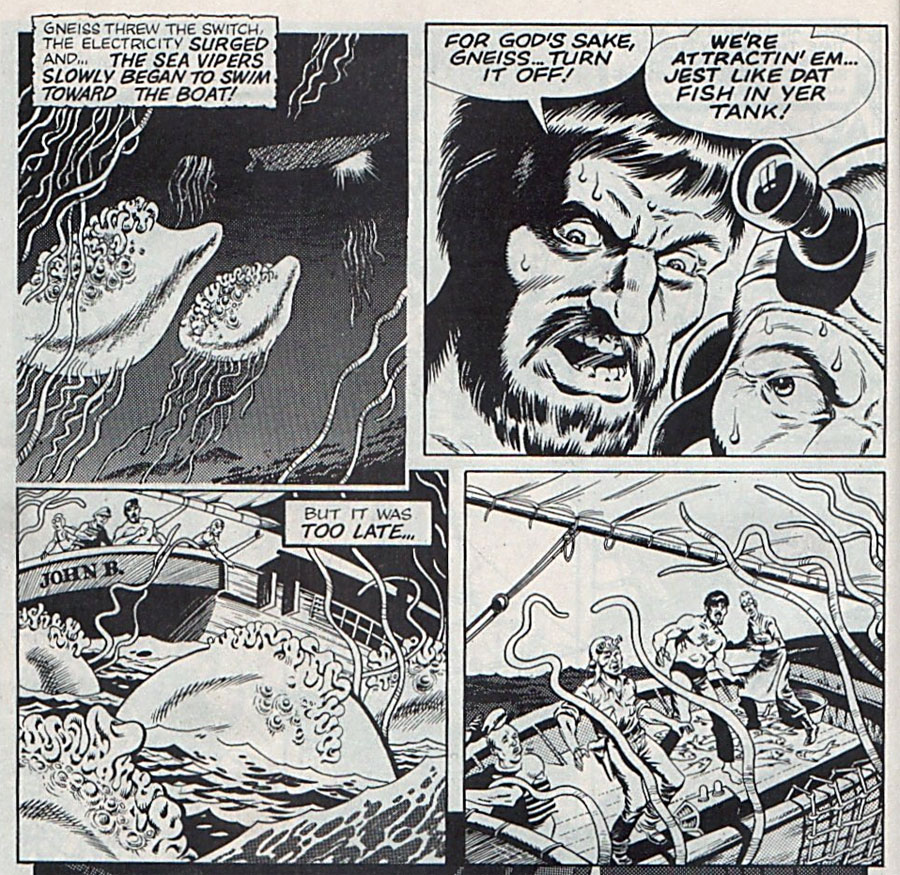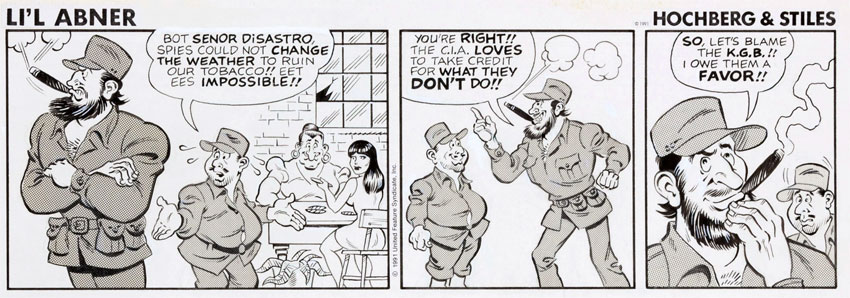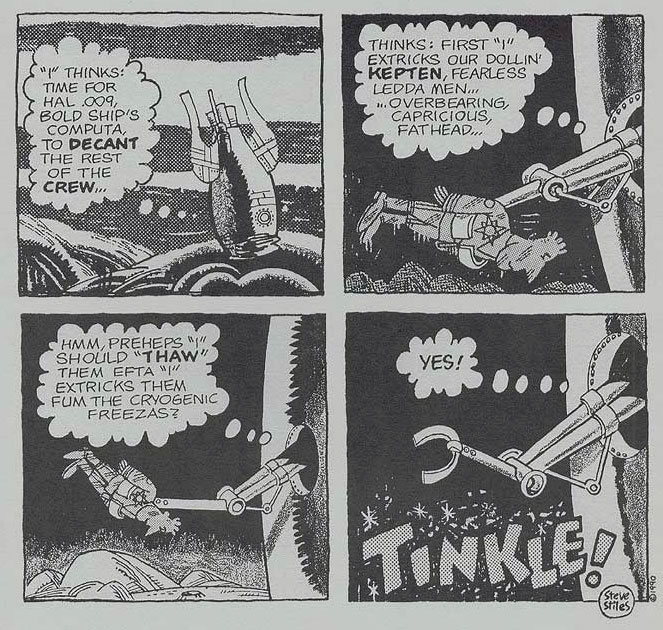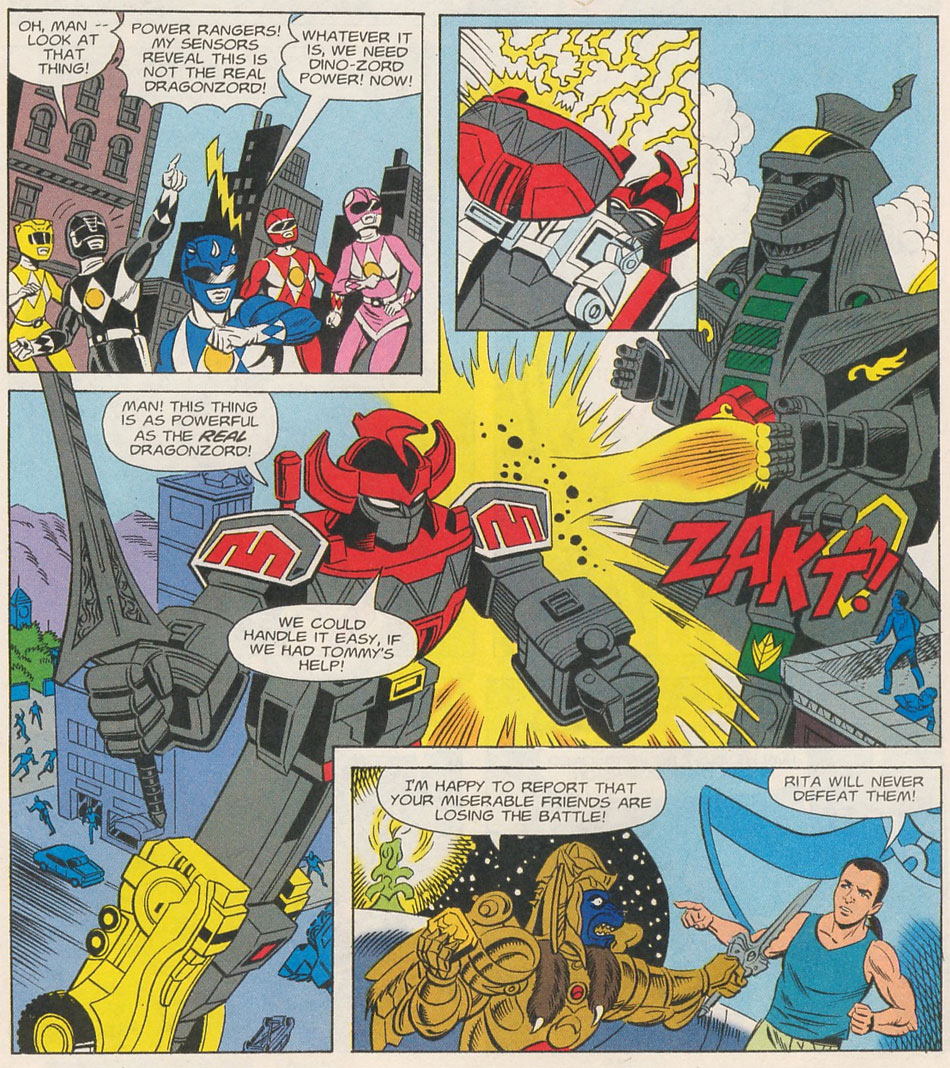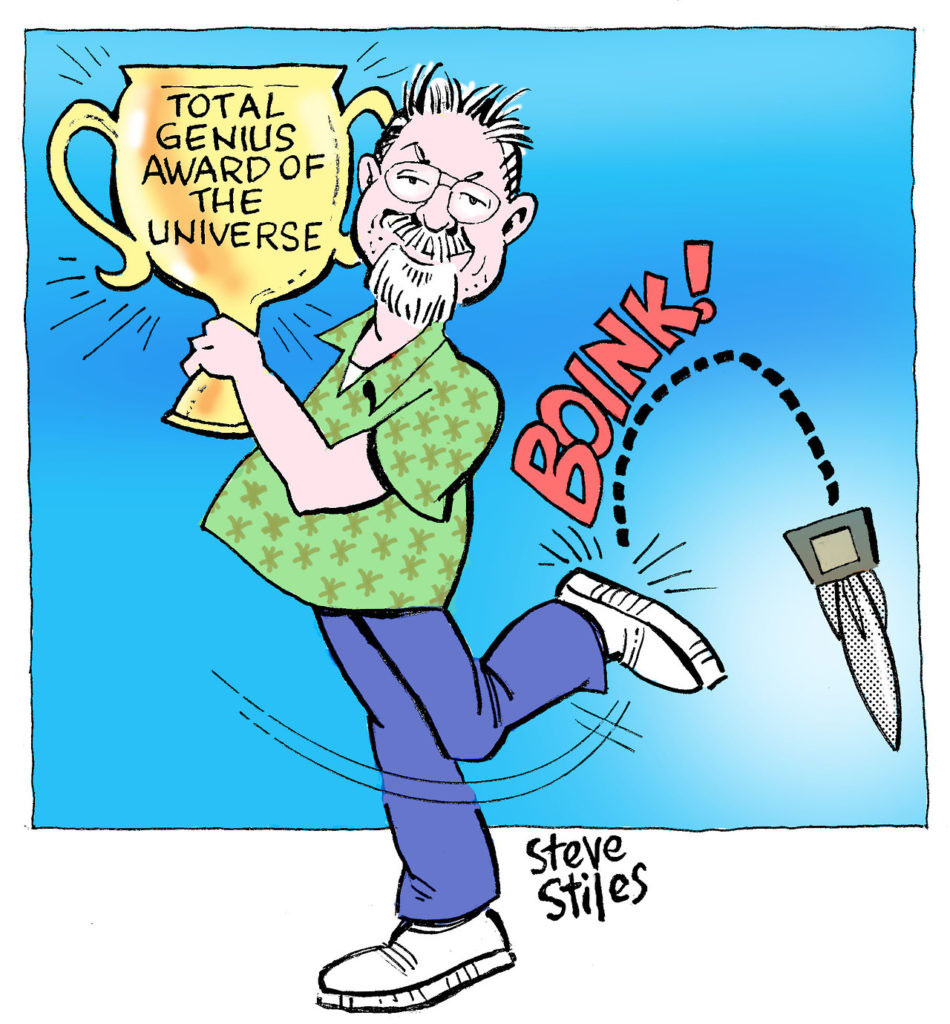'Last Exit!' (Death Rattle #8, 1986).
Steve Stiles was a prominent writer, critic and illustrator in the American sci-fi fan scene, active from the mid-1950s up until the 2010s. In 1956, he launched his own long-running but irregularly appearing fanzine, Sam, of which the final issue appeared in 2014. Stiles also coined the catchphrase "Death is nature's way of telling you when to stop." Throughout his long career, Stiles was additionally active as a comic artist, but had almost proverbial bad luck. Many times he applied to continue or reboot certain series, but was rejected at the final minute. While his work appeared with several professional publishing companies, the series or magazines he worked for were often suddenly discontinued for one reason or another. Stiles is most notable for his humorous and long-running steampunk series 'The Adventures of Professor Thintwhistle and his Incredible Aether Flyer' (1966), scripted by Richard Lupoff. His biggest mainstream success was as back-up feature artist in the post-apocalyptic dinosaur series 'Xenozoic Tales' (AKA 'Cadillacs and Dinosaurs', 1987-1996), written by series creator Mark Schultz.
Early life
Stephen Willis Stiles was born in 1943 in Manhattan, New York City. His Sunday school teacher happened to be Harvey Comics artist Sid Couchey, who encouraged his drawing talent. Stiles loved EC Comics, both their horror, mystery and science fiction output, as well as their satirical magazine Mad. His favorite artists at the company were Harvey Kurtzman, Will Elder and John Severin. At age fourteen, he and some friends visited the offices of Humbug Magazine, where they met Harvey Kurtzman and his secretary Gloria Steinem (who later became famous as a feminist activist). As a teenager, Stiles also met veteran cartoonists like Vernon Van Atta Greene, Wallace Wood and Edwin Laughlin. Apart from EC Comics, Stiles also ranked Harold Gray, Al Capp, Will Eisner, Frank Robbins, Ross Andru, Walt Kelly and Jerome Martin among his graphic influences. Since EC's sci-fi titles often adapted short stories by novelist Ray Bradbury, Stiles went to his local library to check out more of his books. After devouring all available titles, he delved into other science fiction writers too, including Robert A. Heinlein, Isaac Asimov and Fritz Leiber. It made him a lifelong science fiction fan.
As an 11th grade pupil at the High School of Music & Art in Manhattan, Stiles had a traumatic experience, when his art teacher committed suicide in full view of the entire class by jumping out of the window. A couple of years later, when he was walking down the street, another suicidal person crashed down on the concrete just behind him. Through a recommendation letter by Vernon Van Atta Greene, Stiles was later accepted at the School of Visual Arts in Manhattan, where many legendary cartoonists were once pupils or, like Burne Hogarth, teachers. After his graduation in 1964, Stiles worked as a photo retoucher and graphic artist for advertising agencies. He kept this profession until 1976, when he moved to Baltimore, Maryland.
Cover illustration for Eli Cohen's Kratophany #3 (1973), and a poster for the 1981 Worlds Beyond convention.
Fanzines
As a teenager, Stiles discovered that many fellow American youngsters published fanzines. Some were originally high school or college magazines imitating Mad Magazine before they went professional. Others were devoted to specific niches, like science fiction. Stiles was eager to become part of this scene. While reading an issue of Science Fiction Adventures, he noticed a pen pal letter request. Stiles wrote to this person, which started off a correspondence. Most of the time, they talked about science fiction, but sometimes Stiles doodled some cartoons on the envelopes or added them to his letters. In 1956, his pen pal published one of his amateur comic strips, 'The Adventures of Arthur Brown', in The Yardville Youth Center fanzine. The thrill encouraged Stiles to launch his own fanzine Sam, which he continued all through high school. By bringing a couple of issues to his entrance exam at the School of Visual Arts in Manhattan, the teachers actually offered him a three-year scholarship. Even though his later professional life made it more difficult to publish new issues on a regular basis, he kept going. After issue #14 in 1974, it took almost a decade (1983) before his 15th issue of Sam came out. To the surprise of many, a final issue was published three decades later, in June 2014, for a science fiction convention in Richmond, Virginia, organized by the fanzine Corflu.
In 1961, four cartoons by Stiles were published in the leading fanzine of that moment, Paul Krassner's The Realist. The Realist stood out because of its high production values, cynical style of comedy and left-wing political-social commentary. In many ways it was a precursor to later independent counterculture magazines, and enjoyed a long lifespan. However, Stiles originally felt its style of comedy was too dark. Therefore he looked for other magazines willing to give him a contract. Still he was quite thrilled that one of his cartoons, in which Hugh Hefner was named "a virgin", was framed and hung in his office by the legendary Playboy editor himself. Stiles also saw the impact of one of his interlineations in popular culture. In the fanzine Cry of the Nameless, he used the line: "Death is nature's way of telling you when to stop," which in 1962 became a catchphrase, after being reprinted in Pageant. Over the decades, Stiles' articles and occasional comics appeared in many different U.S. fanzines, including Algol, Ansible, File 770, Locus, Mimosa, SF Commentary, Xero, Trap Door, Void and Vojo de Vivo. He was a regular appearance at numerous conventions and thus one of the most recognizable names in the "Baltiwash" (Baltimore-Washington, DC) fanzine community. In 1981, he married fellow fanscene member Elaine Mandell, who edited several clubzines of the Baltimore Science Fiction Society. Steve Stiles' best articles have been collected and published in book format as 'Harrison County' (2007).
'Professor Thintwhistle and his incredible Aether Flyer'.
The Adventures of Professor Thintwhistle
In 1966, Steve Stiles and author Richard Lupoff created the science fiction comic series 'The Adventures of Professor Thintwhistle and his Incredible Aether Flyer', which ran in Lupoff's fanzine Horrib. The concept was inspired by Lupoff's penny dreadful collection, a series of late 19th-century, early 20th-century crime and horror stories. However, Stiles and Lupoff took all the action to outer space, into the far future. Thintwistle is a typical mad scientist, who uses a steam locomotive-like machine to fly through space. 'Professor Thintwhistle' can be described as steampunk, long before it became an actual literary genre. In 1974, Lupoff adapted the concept into a literary novel, with a cover illustrated by Frank Frazetta. At the suggestion of editor Ted White, the comic series was rebooted, updated and continued from 1979 on in Heavy Metal magazine. All episodes of Stiles' signature series were adapted into a 1991 graphic novel, published by Fantagraphics, with a foreword by Neil Gaiman.
Horror comics
In issue #28 (August 1969) of the horror comic magazine Creepy, Steve Stiles and fellow artist Bhob Stewart provided the artwork for the story 'Valley Of The Vampires', scripted by Arnold Hayes. He later looked back on the story as an old shame, since he didn't have time enough to do a good job on it. In the second issue (October 1975) of the Charlton Comics title 'Beyond The Grave', Stiles illustrated the one-page comic story, 'Bats!', written by Michael Pellowski.
'Adolf Hitler Funnies' (Commies from Mars #1, 1973).
Underground comix
At the turn of the 1960s into the 1970s, many independent publishers printed underground comix. Stiles was quick to join the scene. In 1963, he drew two Tijuana Bible porn comics for Al Shuster with the classic cartoon characters 'Little Orphan Annie' and 'Buck Rogers' in the starring roles. In 1968, after the death of 'Little Orphan Annie' creator Harold Gray, Stiles actually tried to apply as his successor. He sent in some comics (not his Tijuana Bible version!), but the syndicate had already hired somebody else by that point. In 1969, a one-page underground comic by Steve Stiles and Dick Lupoff, 'The Adventures of Isadore', was printed in issue #4 of Gothic Blimp Works, the Sunday underground supplement of The East Village Other. Isadore was a representative of Joe Q. Public, a typical target in counterculture magazines. Originally his comic strip counted three pages, but the editors only ran the first one. According to the artist, when he went to the office to inform why they hadn't printed the rest, the editors flat-out told him that they "didn't know and didn't care", whereupon Stiles told them to fuck off and didn't make an underground comic again for years.
Eventually, Stiles found a more receptive publishing company at Kitchen Sink Press, edited by Denis Kitchen. His first underground comic, 'Adolf Hitler Funnies', ran in the first issue of Commies from Mars (March 1973). Stiles was a regular appearance in the magazine Snarf, for which he drew several one-shot short stories: 'Let's Be Happy' (issue #5, March 1974), 'Dream House Bliss', 'Kill a Guru!' (issue #7, February 1977), 'Joe Stalin Tells Me What to Draw!', 'Piece O' The Action!', 'Livestock Funnies', 'It's The Pits!' (issue #8, October 1978), 'He's Gone!', 'Yes It's Me!', 'Close Encounters of the Irritating Kind!', 'Li'l Grunt the Cute Lil' Prehistoric Reptile!' (issue #9, February 1981), 'Work and Win' (issue #14, March 1990) and 'Just Walkin' the Dog' (issue #15, October 1990). Snarf also published a one-shot special, Mondo Snarfo (September 1978), for which Stiles created three exclusive new stories: 'Life's Improper Number', 'Koyp! For Heavy Intellectual Enjoyment!' and 'More Iron the Psycho-Civilized World!'.
'Tomorrow On Parade' (Comix Book #3, 1975).
In October 1974, Kitchen Sink Press struck a deal with the mainstream publishing company Marvel Comics to produce the underground comic magazine Comix Book. Stiles created a comic for the first issue, 'We Are Watched', followed by a three-page post-apocalyptic comic 'Tomorrow on Parade' in issue #3 (March 1975) and the one-page gag comic 'Let's Be Happy' in issue #4 (February 1976). Stiles went a sleazier route when drawing weird pornographic comics for Bizarre Sex. In issue #5 (October 1976), he contributed 'Sewer Love' and 'Avatar of Pain!'. In the following issue (October 1977), one could read his comics 'Abrey Spittle', 'Partially Dissolved', 'Wet Mouth Follies' and 'Bizarre Sex Murder'. The seventh issue (February 1979), offered 'Arcane Love' and 'Passing Through', while he wrote and drew 'Sex Captives of the Slaver Void!' and 'Green Pastures' for issue #8 (March 1980). His final contribution, 'Horrible Teeth Grinding Moments We'd Like to Forget but Probably Never Will' in issue # 10, happened to be the final issue altogether (December 1982).
In addition, Stiles drew comics for the short-lived magazine Dope Comix, which featured satirical tales about junkies and other trippy stories. In the very first issue (February 1978), he drew 'Super Science Action Wonder Stories' and 'Fun With Dope!' Since the editors intentionally published the issue numbers in backwards fashion, the second issue (February 1981) was actually titled number 4. Confused readers found Stiles' one-shot comics 'Feb. 21, 1965' and 'Dope Trauma Tales' within. The third issue (June 1981) was indeed numbered #3 and featured two comics by his hand: 'L.S.D.' and 'Jim Baxter: Marijuana Detective'. However, the fourth issue (June 1982) was numbered two again. It ran his comics 'This Is The Life!' and 'Clown's Pain'. The fifth and final issue was labeled issue #5 (January 1984) and featured the autobiographical tale 'My First Marijuana Experience!' and the more comedic 'Them Flatulent Fuggheaded Fiend Brothers'. In March 1979, Kitchen Sink Press published a one-shot alternative comic book, 'Hyper Comics', fully written and drawn by Steve Stiles. He ironically named himself "Baltimore's number one cartoonist" on the cover, knowing well that it wouldn't sell well. Apart from Kitchen Press, Stiles additionally appeared in Last Gasp's Anarchy Comics issue # 2 (1979) with the story 'Wobblies!'.
'Radium Fun!' (Hyper Comics, 1979).
Marvel and DC
Starting in 1975, for a period of five years, Stiles worked as a penciler for Marvel UK, the British division of Marvel Comics. His artwork appeared in issues #25-26 and 37 of 'The Titans'. He drew the story 'My Son the Man-Wolf!' in Spiderman issue #173 (5 June 1976), in which Spider-Man fights Man-Wolf. For Captain Britain issue #3 (27 October 1976), Stiles penciled a two-page story featuring 'Nick Fury and his Agents of SHIELD'. Later, Stiles worked on the children's comic 'Royal Roy', published by Marvel's U.S. imprint Star Comics. The character, created in 1985 by Lennie Herman and Warren Kremer, was basically a rip-off of Harvey Comics' 'Richie Rich', created by Alfred Harvey and also drawn by Warren Kremer. Both were boy millionaires and most of the comedy revolved around their wealth. Stiles illustrated the story 'Great Scout', scripted by Angelo DeCesare, which ran in issue #5 (January 1986) and #6 (March 1986). Despite decent sales, the entire series was discontinued when Harvey Comics threatened to sue for plagiarism.
Only once, Steve Stiles worked for Marvel's main rival DC Comics. For the 1977 '5-Star Super-Hero Spectacular', volume #1 in the DC Special Series, he drew the peculiar comic story 'The Telephone Tangle' (1977), starring the company's superhero The Atom. Scripted by Paul Kupperberg, the story featured the Atom traveling back in time to meet inventor Alexander Graham Bell.
Science fiction comics in the 1980s
For the science fiction comic magazine Alien Encounters, published by FantaCo Enterprises, Stiles drew 'Chairman Mao and the Men From Mars' (1981), an odd story featuring the late Chinese dictator Mao in a Martial Invasion story. Stiles really blossomed in Kitchen Sink Press' horror and SF comics anthology Death Rattle, where he drew one-shot stories like 'Mind Siege!' (issue #3, February 1986), 'Last Exit!' (issue #8, December 1986) and 'The Arrivals' (issue #12, September 1987). The only story he didn't write himself was 'This Old House' (issue #7, October 1986), for which Kenneth Whitfield served as scriptwriter.
'Crossed Currents' (Xenozoic Tales #7, October 1988).
Xenozoic Tales
Stiles' connection with the SF anthology Death Rattle actually led to his best known work among mainstream audiences. In Death Rattle issue #8 of December 1986, writer and artist Mark Schultz published a story about a post-apocalyptic future where dinosaurs have made a comeback, 'Xenozoic!'. Under the title 'Xenozoic Tales' (February 1987), it spawned its own comic book series, also published by Kitchen Sink Press, which ran irregularly until 1996. While Schultz remained the comic's main writer and artist, Stiles illustrated a back-up story in every issue, scripted by Schultz. Set in the far future, when pollution and war have caused Earth's survivors to live underground for 500 years, mankind eventually dares to return to the surface. It turns out many extinct lifeforms have returned, including dinosaurs.
The series focuses on Jack Tenrec, a garage mechanic who restores old cars, especially Cadillacs, because all technology is very primitive. Since oil is scarce, people use dinosaur guano instead. Tenrec shares his garage with a female scientist, Hannah Dundee, an elder mechanic, Kirgo, engineer Mustapha Cairo and an Allosaurus "watch dog" named Hermes. Over the course of the series, Jack and Hannah grow closer together. Tenrec has befriended a reptilian humanoid race, The Grith, with whom he communicates telepathically. Recurring antagonists are the Terhunes, a group of poachers. The stories were influenced by Robert J. Swayer's popular 'Quintaglio Ascension' novels, as well as Al Willliamson's comic strip 'Sound Of Thunder'. In 1993, 'Xenozoic Tales' was adapted into an animated TV series, 'Cadillacs and Dinosaurs', produced by Nelvana, though it had little to do with the original. Marvel and later Topps Comics reprinted old issues of 'Xenozoic Tales' under the title 'Cadillacs and Dinosaurs'.
While 'Xenozoic Tales' did well, Stiles was quite disappointed when he was packing Robert Crumb T-shirts for a living and a co-worker showed him that Crumb had criticized his comic in an issue of Despair. In said issue, Crumb portrays himself throwing away copies of 'Cadillacs and Dinosaurs' in the trash. It was particularly hurtful, since only days earlier, Stiles had actually defended Crumb's work in conversation with a black female co-worker who felt he was a "racist, male chauvinist pig". Stiles wrote to the underground comix legend, asking him why he disliked 'Cadillacs and Dinosaurs'. Crumb answered that he didn't like action or superhero comics in general. Stiles found a way to retaliate by selling Crumb's answer letter for 600 dollars. With the money he bought some prog rock albums, a symbolic middle finger to Crumb, who was infamous for disliking pop music.
Unused 'Li'l Abner' sample strip by Steve Stiles (1991), featuring Fidel Castro.
Other work in the 1980s and 1990s
For Adventure Publications' 'Adventures' series (1987-1988), Stiles was an inker on 'Crimson Letters Part 5: A New Seed' and 'The Grail of Darkness - Chapter 1', written by Scott Behnke, Dan Greenberg and Mark Ellis, while Butch Guice and Kent Burles provided artwork. In the first issue of 'Warriors' (November 1987), he inked Dan Greenberg and Adam Hughes' 'Two Sides of the Man'. Stiles wrote and drew the comic strips 'Aliens Among Us' and 'On the Bright Side' (1986) for the SF fanzine Stardate. In 1990 Stiles was asked to revive Al Capp's classic newspaper comic 'Li'l Abner', which had been discontinued since 1977. Since he was a huge fan, he made a couple of try-outs. Much to his delight he was selected, but once again the entire project was prematurely axed when Capp's heirs objected to the relaunch.
Stiles additionally worked as an inker for Malibu Comics. He inked the title story in 'Death by Ecstasy!' (1991), a comic book based on Larry Niven's science fiction novels of the same name. In the same book, he also inked two other stories, namely 'The Organleggers' and 'Heart Attack', all scripted by Bill Spangler, while Terry Tidwell penciled. He inked for the same people and company with the SF series 'The Defenseless Dead' (issues #1-3, February-April 1991). Stiles was also present as the artist behind the mini-series 'Doc Savage: Devil's Thoughts' (August-October 1992), published by Millenium Publications. Scripted by Mark Ellis and Darryl Banks, this adventure series was based on the popular 'Doc Savage' novels, originally created in 1933 by Henry W. Ralston, John L. Nanovic and Lester Dent. For Hamilton Comics, Stiles drew and inked the horror comics 'Maggots' (1991-1992), 'Grave Tales' (1991) and 'Dread of Night' (1992). In 1995, he was asked to draw a comic book adaptation of the popular children's TV series 'Mighty Morphin' Power Rangers'. A well-paid job, he drew three issues, after which Hamilton's comic book adaptations of the TV show were taken over by Marvel, who put their own writers and artists on the job, leaving Stiles without his.
'Aliens Among Us' (appearing on the cover of BSFAN #18, the clubzine of the Baltimore Science Fiction Society).
Graphic contributions
In 1977, Steve Stiles, Howard Cruse and Peter Loft created the subversive Christmas card series "Kruppcards". In 2008, Stiles designed the annual Samaritan Peace and Humanitarian Achievements Medal. In February of that year, Israeli President Shimon Peres was the first winner. Stiles also livened up the covers for Harry Warner's book 'A Wealth of Fable: An Informal History of Science Fiction Fandom in the 1950s' (SCIFI Press, 1992) and the reprint edition of 'All Our Yesterdays: An Informal History of Science Fiction Fandom in the 1940s' (NESFA Press, 2004). In 2018, Fantagraphics compiled the best from Wallace Wood's witzend magazine. The story 'Last Act of a Living Legend', written by Bill Pearson and penciled and inked by Steve Stiles was originally intended for witzend issue #14. That issue however never appeared, since a fire destroyed all the planned material. For the 2018 Fantagraphics book, Pearson and Stiles remade their story, working from copies. Thanks to their efforts, their humorous tale about Elvis Presley coming back from the dead as a serial killer has been preserved for future generations.
Online activities
After 1995, most of Stiles' professional activities in the comics world came to an end. Yet he did find a new pastime writing articles about comics for ChannelSpace Entertainment. Together with former Heavy Metal editor Ted White, he worked on Collectingchannel.com, a sales site devoted to the subject of comics. In 2005, his now-defunct personal website SteveStiles.com was launched.
Recognition
Steve Stiles won the Trans-Atlantic Fan Fund Award (1968), a Harvey Award for Best Single Issue or Story (1992), the Bill Rotsler Award (1998) and 11 Fan Activity Achievement Awards in 2001, 2003-2006, 2010-2012 and 2014-2016. In 2016, after having been nominated 14 times without winning, he won the Hugo Award for Best Fan Artist.
Final years and death
In 2017, Steve Stiles was diagnosed with lung cancer. His tumor was surgically removed, but on 7 January 2020, he announced online that his illness had returned. He informed everybody that it was terminal and expected to have "a few months, more or less." Only four days later, on the 11th, he passed away at age 76.
'Saban's Mighty Morphin' Power Rangers Saga' #3.
Legacy
Steve Stiles and his friends often joked that he seemed to be born under a bad sign. While he invented a popular catchphrase, "Death is nature's way of telling you when to stop", he couldn't copyright it, thus never being able to commercialize it. Throughout his life, he constantly tried to launch mainstream comic series, either in papers, comic books or magazines. Sometimes, like with 'Little Orphan Annie' and 'Li'l Abner', his try-outs were rejected at the final minute. Other times, like with 'Isadore' at Gothic Blimp Works, the editors canceled his feature. Most of his comics remained one-shots, while the magazines in which he published were often discontinued. While he managed to get into the legendary magazine witzend, his artwork was lost in a fire before publication. The one time Robert Crumb namedropped him in a comic it was in a negative way. Stiles found a homebase in the underground comix scene in 1973, when the genre was already dying out. In the 1990s, his best-paid job, working on 'Saban's Mighty Morphin' Power Rangers Saga' comics for Hamilton, was abruptly discontinued once Marvel bought the rights. By 1995, Stiles therefore more or less quit the comic industry. In the late 2010s, however, he started working on an ambitious 200-page historical graphic novel. Yet he was struck by cancer and died before he could finish it.
Despite all the setbacks, Stiles' career still harbored many achievements. He was much appreciated within the U.S. fanzine world, especially in the field of science fiction. Many of his writings, comics and cartoons at least found a regular spot there, and later online. Contrary to many fan cartoonists, Stiles at least had a taste of mainstream notability, by appearing in several legendary 1970s underground magazines and seeing work published at Marvel and DC. Several of his comics were reprinted in other magazines, even in Europe, and collected in graphic novel format. As his list of awards proves, his efforts weren't unrecognized either. In a podcast interview posted on 19 April 2019 on scottedelman.com, Stiles said that the most rewarding moment happened when he met Will Eisner who, upon hearing his name, said that he liked his work.
Books about Steve Stiles
On 20 August 2020, Michael Dobson and the artist's wife Elaine Stiles released a posthumous anthology of Stiles' work, 'The Return of Hyper Comics' (2020), which has a foreword by Denis Kitchen.


